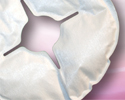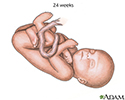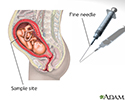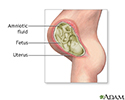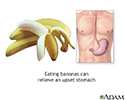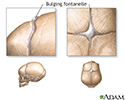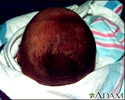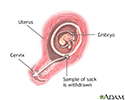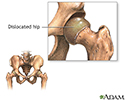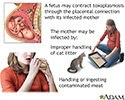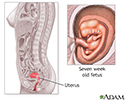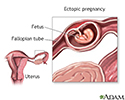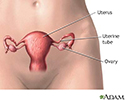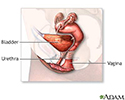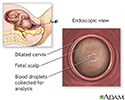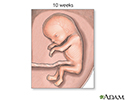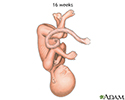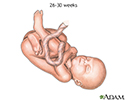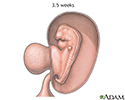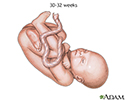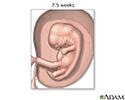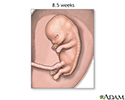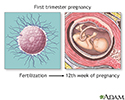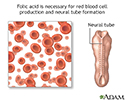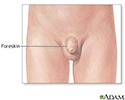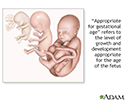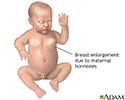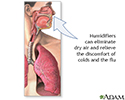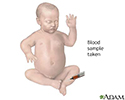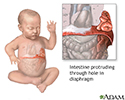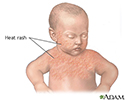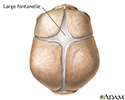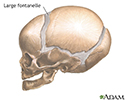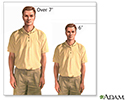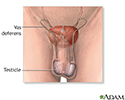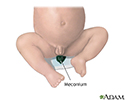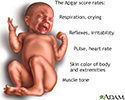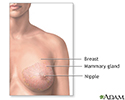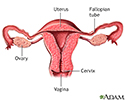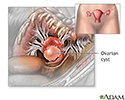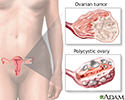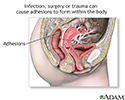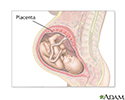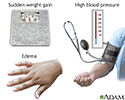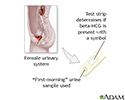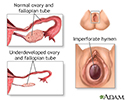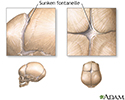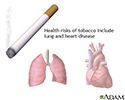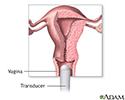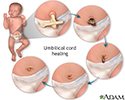Multimedia Gallery
Breast engorgement
It's normal during the first week after a baby is born for a mother's breast to become heavy, and tender, and full as the milk is coming in. And even before that as the blood flow is expanding and the lymph flow is expanding to allow the milk to come in. But sometimes that progresses to something we call engorgement. I'm Dr. Alan Greene and I want to talk briefly about engorgement. What causes it, how you can prevent it, and what to do if engorgement does happen.
We call it engorgement if the pain becomes really severe because the milk is so full in the breasts that it squeezes shut some of the blood and lymph vessels. So causes swelling in the tissues. It's not just too much milk. It's real swelling of the breasts. And it can be quite painful and make nursing kind of difficult.
Probably the best way to prevent engorgement is frequent, early feeding. If you feed as often as the baby wants to, and at least every 2 to 3 hours when the baby is awake during the day, and no longer than 4 or 5 hours one stretch at night during that first week will often prevent engorgement. Engorgement is less common, too, if you don't do supplemental feedings.
But even if you do everything perfectly, some women will still become engorged. It's not a guarantee. If you do and don't do anything, the engorgement will likely last for 7 to 10 days. But if you take steps to treat the engorgement, usually it will be gone within maybe 24 to 48 hours, at least the worst part of it.
So what does treating engorgement mean? It's a couple of very simple steps. The first one is really to try to empty the breasts completely. Again, going back to frequent feeding and to encourage the baby to nurse to finish the first breast first. Don't try to switch breasts in between, but start and let them empty as much as they can. And then only after they come off it at their timing, try the other breast. Then start with the opposite one next time.
Then you can do a lot with cool and warm compresses. Doing a cool compress in between nursing can help reduce the swelling and reduce the tenderness. And then a warm compress you want to switch to in the 10 to 15 minutes before nursing to help encourage let down and help the breast drain more fully. You can actually get compresses that are made for this purpose that you can warm or you can cool. And they can fit inside a nursing bra.
Another thing that can be very helpful are cabbage leaves. There have been a few studies suggesting this and a lot of personal experience people have had just taking a cabbage leaf out of the refrigerator and wearing it as a compress. There seems to something in there that does help. Whatever you do, you may also want some pain relief, something like acetaminophen. And if that's necessary don't hesitate if that's something that's going to keep you nursing because breast milk is the very best thing for kids.
Breast engorgement
Review Date: 7/1/2025
Reviewed By: Neil K. Kaneshiro, MD, MHA, Clinical Professor of Pediatrics, University of Washington School of Medicine, Seattle, WA. Also reviewed by David C. Dugdale, MD, Medical Director, Brenda Conaway, Editorial Director, and the A.D.A.M. Editorial team.
Animations
- Breast engorgement
- Cell division
- Cesarean section
- Conception - general
- Conception - pregnancy
- Conception of identical twins
- C-section
- Early labor
- Egg cell production
- Egg production
- Endometriosis
- Fetal ear development
- Formation of twins
- Human face formation
- Infant formulas
- Kids - How big is the baby?
- Kids - How does the baby co...
- Kids - Is it a girl or boy?
- Kids - Umbilical cord
- Kids - Where do babies come...
- Newborn jaundice
- NICU consultants and suppor...
- Ovulation
- Placenta delivery
- Placenta formation
- Preeclampsia
- Pregnancy
- Pregnancy care
- Sperm production
- Sperm release pathway
- Storing breast milk
- The role of amniotic fluid
- Twin-to-twin transfusion sy...
- Ultrasound
- Vaginal delivery
Illustrations
- 24-week fetus
- Abnormal discharge from the...
- Abnormal menstrual periods
- Absence of menstruation (am...
- Amniocentesis
- Amniocentesis
- Amniotic fluid
- Amniotic fluid
- Anatomy of a normal placenta
- Antibodies
- Baby burping position
- Bananas and nausea
- Blood cells
- Blood test
- Breast infection
- Breastfeeding
- Bulging fontanelles
- Candida - fluorescent stain
- Caput succedaneum
- Cesarean section
- Cesarean section
- Cesarean section
- Childbirth
- Chorionic villus sampling
- Congenital hip dislocation
- Congenital toxoplasmosis
- Crying - excessive (0 to 6 ...
- Delivery presentations
- Developmental milestones
- Early weeks of pregnancy
- Ectopic pregnancy
- Emergency Childbirth
- Emergency Childbirth
- Endocrine glands
- Endometriosis
- Endometritis
- Erythroblastosis fetalis - ...
- Female breast
- Female reproductive anatomy
- Female reproductive anatomy
- Female reproductive anatomy...
- Female urinary tract
- Fetal blood testing
- Fetal head molding
- Fetus at 10 weeks
- Fetus at 12 weeks
- Fetus at 16 weeks
- Fetus at 26 to 30 weeks
- Fetus at 3.5 weeks
- Fetus at 30 to 32 weeks
- Fetus at 7.5 weeks
- Fetus at 8.5 weeks
- First trimester of pregnancy
- Folic acid
- Folic acid benefits
- Folic acid source
- Follicle development
- Fontanelles
- Foreskin
- Gestational ages
- Gestational diabetes
- Gonadotropins
- Head circumference
- Heat rash
- Height/weight chart
- Hormonal effects in newborns
- Humidifiers and health
- Hysterectomy
- Infant blood sample
- Infant care following delivery
- Infant diaphragmatic hernia
- Infant heat rash
- Infant intestines
- Infant jaundice
- Infantile reflexes
- Influenza vaccines
- Intraductal papilloma
- Intrauterine transfusion
- Jaundiced infant
- Large fontanelles
- Large fontanelles (lateral view)
- Macrosomia
- Male reproductive anatomy
- Male reproductive anatomy
- Male urinary tract
- Mammary gland
- Meconium
- Morning sickness
- Moro reflex
- Newborn head molding
- Newborn test
- Normal female breast anatomy
- Normal uterine anatomy (cut...
- Ovarian cyst
- Ovarian hypofunction
- Overproductive ovaries
- Pelvic adhesions
- Pelvic laparoscopy
- Placenta
- Placenta
- Placenta
- Placenta previa
- Polyhydramnios
- Preeclampsia
- Pregnancy test
- Primary amenorrhea
- Primary infertility
- Secondary amenorrhea
- Secondary infection
- Side sectional view of fema...
- Single palmar crease
- Skull of a newborn
- Slit-lamp exam
- Sperm
- Stein-Leventhal syndrome
- Sunken fontanelles (superio...
- Tobacco health risks
- Transvaginal ultrasound
- Ultrasound in pregnancy
- Ultrasound, color - normal ...
- Ultrasound, normal fetus - ...
- Ultrasound, normal fetus - ...
- Ultrasound, normal fetus - ...
- Ultrasound, normal fetus - face
- Ultrasound, normal fetus - ...
- Ultrasound, normal fetus - foot
- Ultrasound, normal fetus - ...
- Ultrasound, normal fetus - ...
- Ultrasound, normal fetus - ...
- Ultrasound, normal fetus - ...
- Ultrasound, normal placenta...
- Ultrasound, normal relaxed ...
- Umbilical cord healing
- Uterus
- Vaginal bleeding during pre...
- Well baby visits
- Yeast infections

 Bookmark
Bookmark



























